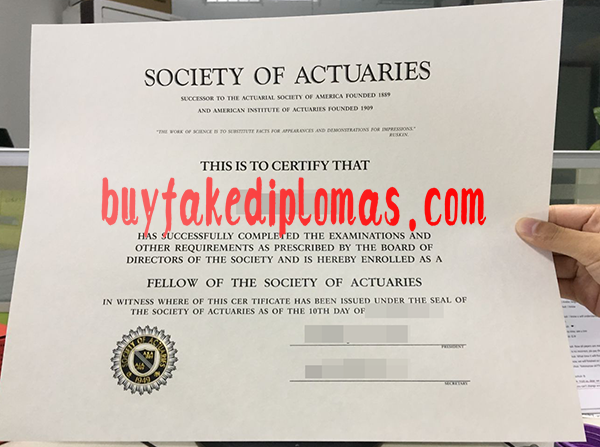We provide the best service at the most favorable price in the market. The original stamps / stickers, perfect and authentic seal and badge samples help you obtain the ideal certificate add our whatsapp: +86 15179517591
Who needs to buy Fake Society of Actuaries Certificate?

Society of Actuaries Certificate
The Society of Actuaries of North America, buy fake Society of Actuaries Certificate, founded in 1889, is the largest actuarial professional organization in the world, with more than 32,000 actuaries. SOA’s mission is to improve actuaries’ ability to provide expert advice and relevant solutions to financial, business, and societal challenges. SOA’s vision is for actuaries to be leading professionals in measuring and managing risk. Founded in 1889, shopping fake Society of Actuaries Certificate, purchase fake Society of Actuaries Certificate, the Society of Actuaries (SOA) is the largest and most authoritative actuary organization in the world. It is mainly divided into two stages: quasi actuary and actuary. The examination is based on credit system. fake Society of Actuaries Certificate for sale, A total of 450 credits are required to obtain the final actuary qualification. The conditions are relatively simple, as long as you are interested in this major, you can start, but once you start, it is a long time line and a certain degree of difficulty of the road to the examination. Who needs to buy Fake Society of Actuaries Certificate?
The Actuarial Society of North America has made two significant revisions to its examination system since the 1990s (1995 and 2000). Take the quasi-actuary examination courses as an example. Before 1995, there were 10 courses in total, which were: Calculus and linear algebra, probability theory and mathematical statistics, Operations research, numerical analysis, interest theory, actuarial mathematics, risk theory, survival model, population mathematics, and evenness mathematics. Four additional courses have been added since 1995, which are: An Overview of Financial Security Projects, an Overview of Actuarial Practice, an Overview of Asset Management and Public Finance, and Principles of Asset/Liability Management.
North American Institute of Actuaries Quasi-Actuary Program after 2000:
Course 1 Mathematical Foundations of Actuarial Science
Description: The purpose of this course is to develop knowledge of some basic mathematical tools and the ability to assess risk quantitatively, especially the application of these tools to solve problems in actuarial science. It is also assumed that students have mastered calculus, probability theory and basic knowledge of risk management before taking this course. Main contents and concepts: Calculus; Probability theory; Risk management (including frequency of losses; The amount of loss; Reserve amount; The deductible; Co-insurance and risk premiums).
Course 2 Interest Theory, Economics and Finance
Description: This course includes interest theory, intermediate microeconomics and macroeconomics, and fundamentals of finance. A basic knowledge of calculus and probability theory is required before taking this course. Main contents and concepts: interest theory; Microeconomics; Macroeconomics; Fundamentals of finance.
Course 3 Actuarial models of random Events
Description: Through the study of this course, students will develop the basic knowledge of actuarial models of random events and their application in insurance and financial risks. Prior to this course, it is required to master calculus, probability theory and mathematical statistics. It is recommended that participants take this course after passing Courses 1 and 2. Main contents and concepts: insurance and other financial random events; Survival model; Demographic data analysis; Quantitative analysis of the financial impact of random events.
Course 4 Actuarial Modeling Methods
Description: This course provides an initial introduction to the basics of model building and the important actuarial and statistical methods used for modeling. Prior to this course, it is required to master calculus, linear algebra, probability theory and mathematical statistics. Main contents and concepts: Definition of the model; Why and how to use the model; Advantages and disadvantages of the model; Deterministic and stochastic models; Model selection; Input and output analysis; Sensitivity test; Experience and feedback on research results; Regression analysis; To predict; Risk theory; Theory of reliability.
